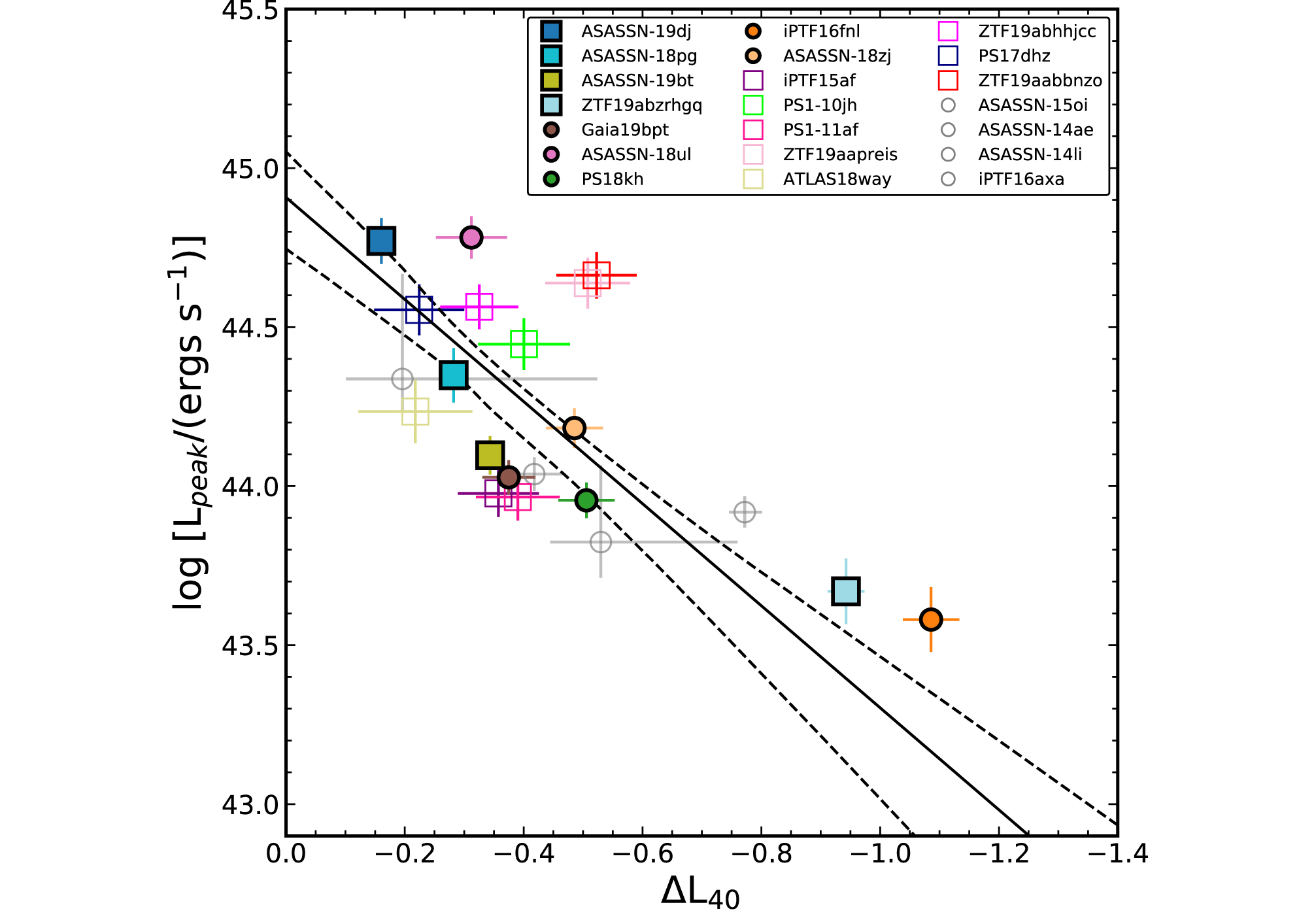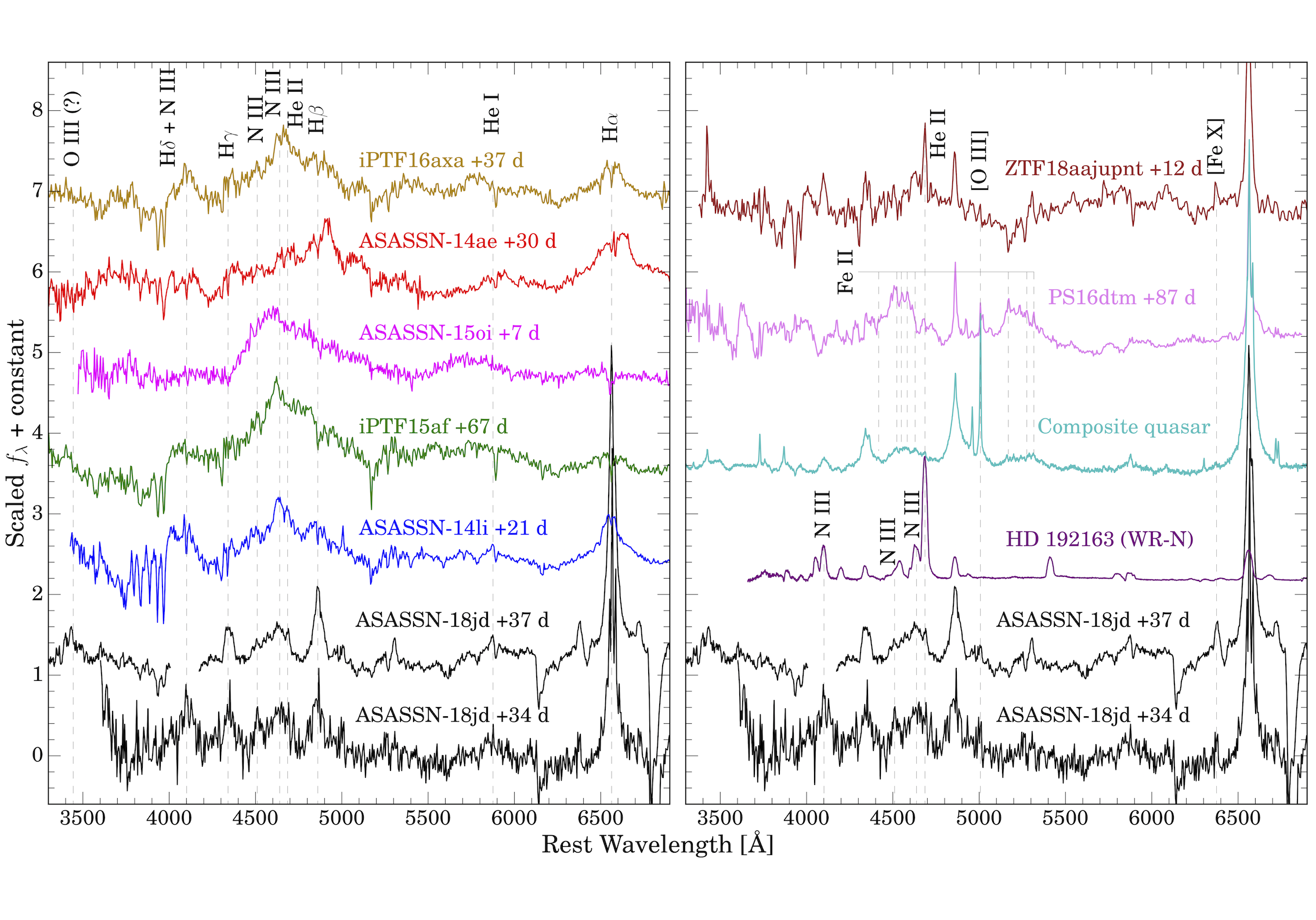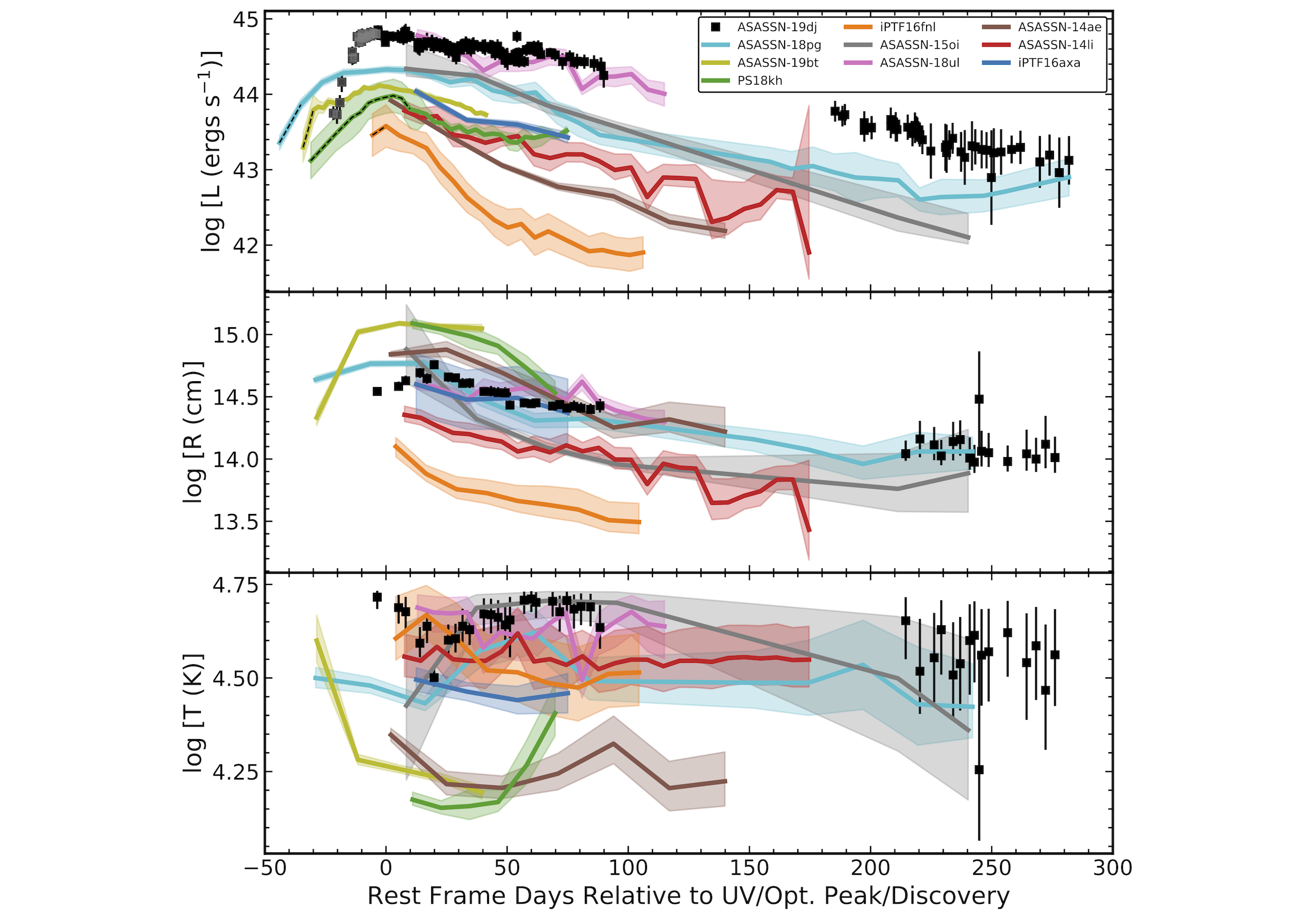Tidal Disruption Events
A tidal disruption event, or TDE, occurs when a star passes too close to a supermassive black hole, where the tidal forces from the black hole overwhelm the star's self-gravity, tearing it apart. Most of the stellar material is ejected from the system, but a fraction remains bound and accretes onto the black hole, resulting in a luminous accretion flare that can last for a year or more. TDEs allow us to study quiescent black holes which otherwise would be impossible to study and give unique insights into accretion physics as we can see the accretion turn on and turn off.
TDEs have only begun to be discovered in significant numbers in the last few years, as all-sky surveys like ASAS-SN have become more common, and still have not been discovered in large enough numbers to develop general theoretical models for TDE emission. ASAS-SN in particular has been a significant source of new TDE discoveries, finding or detecting 10 since 2014. A primary focus of my research has been to obtain high-quality, multi-wavelength datasets for these TDEs in order to build a large sample of well-observed TDEs with which to test our theoretical models of TDE emission and study black holes and accretion. Because TDE emission is often dominated by UV and X-ray emission, these studies have involved data from space telescopes like Swift, Hubble, and Chandra as well as numerous ground-based telescopes.
In addition to early follow-up after discovery, I am also interested in late-time (years after discovery) emission from TDEs, as these observations can illuminate properties of the stellar debris and accretion disk that can't be studied with early emission. I have ongoing projects to continue observing nearby TDEs and their hosts with the Magellan and LBT telescopes to obtain late-time data that has not previously existed.
For more about the TDE papers I have led or been heavily involved in, please see below.
Lead-Author Papers
The Rise and Fall of ASASSN-18pg: Following a TDE from Early to Late Times
Holoien, T. W.-S. et al., Accepted in ApJ (2020)
In this paper we present multi-wavelength observations of the TDE ASASSN-18pg spanning from 54 days before peak to 441 days after peak, which allowed us to look at both the early-time and late-time evolution of a TDE simultaneously for the first time. This paper also contains the first published spectropolarimetric observations of a TDE, which give no strong evidence for significant asphericity in the emission region.
Discovery and Early Evolution of ASASSN-19bt, the First TDE Detected by TESS
Holoien, T. W.-S. et al., ApJ 883, 111 (2019)
ASASSN-19bt is a TDE discovered by ASAS-SN in the TESS Continuous Viewing Zone, and is the first TDE detected by TESS. In this discovery paper we analyze data from TESS, Swift, and ground telescopes spanning from roughly 8 months before first light until about a month after peak, and find that the TDE exhibited some unique observational features that have not been seen before. This paper was the subject of several press releases, as well as a NASA "Live Shots" media campaign during their Black Hole Week in 2019.
PS18kh: A New Tidal Disruption Event with a Non-Axisymmetric Accretion Disk
Holoien, T. W.-S. et al., ApJ 880, 120 (2019)
This is a discovery paper for the TDE PS18kh combining data from Pan-STARRS, ASAS-SN, and ATLAS and using a non-axisymmetric disk model to fit the double-peaked spectroscopic emission lines.
The Unusual Late-Time Evolution of the Tidal Disruption Event ASASSN-15oi
Holoien, T. W.-S. et al., MNRAS 480, 5689 (2018)
This paper presents observations of ASASSN-15oi going out to 600 days after discovery and discusses its unusual late-time X-ray brightening.
ASASSN-15oi: A Rapidly Evolving, Luminous Tidal Disruption Event at 216 Mpc
Holoien, T. W.-S. et al., MNRAS 463, 3813 (2016)
This discovery paper for ASASSN-15oi presents our early light curves and spectra for this nearby TDE.
Six Months of Multi-Wavelength Follow-up of the Tidal Disruption Candidate ASASSN-14li and Implied TDE Rates from ASAS-SN
Holoien, T. W.-S. et al., MNRAS 455, 2918 (2016)
This is a discovery paper for ASASSN-14li, at the time the brightest TDE ever discovered, which has been extensively studied from X-ray through radio wavelengths.
ASASSN-14ae: A Tidal Disruption Event at 200 Mpc
Holoien, T. W.-S. et al., MNRAS 445, 3263 (2014)
This is a discovery paper for ASASSN-14ae, the first TDE discovered by ASAS-SN. It was the subject of an OSU press release.
Selected Additional TDE Papers

Examining a Peak-luminosity/Decline-rate Relationship for Tidal Disruption Events
Hinkle, J. T., Holoien, T. W.-S. et al., ApJL, 894L, 10 (2020)

To TDE or not to TDE: The Luminous Transient ASASSN-18jd with TDE-like and AGN-like Qualities
Neustadt, J. M. M., Holoien, T. W.-S. et al., MNRAS, 494, 2538 (2020)
The Ultraviolet Spectroscopic Evolution of the Low-Luminosity Tidal Disruption Event iPTF16fnl
Brown, J. S., Kochanek, C. S., Holoien, T. W.-S. et al., MNRAS, 473, 1130 (2018)
The Long Term Evolution of ASASSN-14li
Brown, J. S., Holoien, T. W.-S. et al., MNRAS, 466, 4904 (2017)
Hello Darkness My Old Friend: the Fading of the Nearby TDE ASASSN-14ae
Brown, J. S., Shappee, B. J., Holoien, T. W.-S. et al., MNRAS, 462, 3993 (2016)
Banner image credit NASA/JPL-Caltech.
